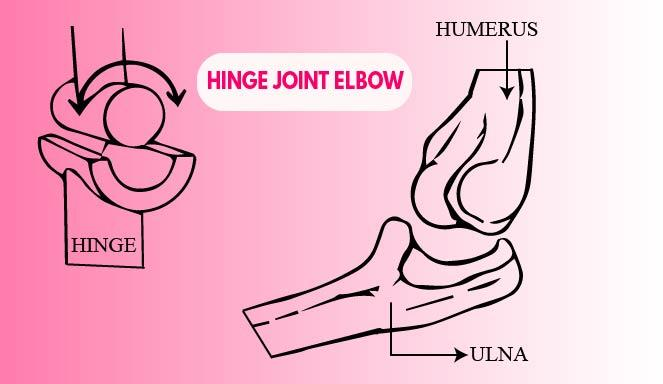
Give two examples of hinge joints.
Answer
507.6k+ views
Hint: This type of joint permits movement in one plane around the transverse axis. This movement consists of flexion and extension. These joints have strong collateral ligaments to prevent other movements.
Complete step by step answer:
In the hinge joint the convex surface of one bone fits into the concave surface of another bone like ulna and humerus in the elbow. This type of joint permits movement on one side only like a door. This movement consists of flexion and extension.
Two examples are the elbow and the phalanges.

Additional information:
Joint in Elbow:
- Articulation: The articular surfaces are covered with hyaline cartilage.
- Type: Synovial hinge joint
- Capsule: From anteriorly it's attached above to the humerus along the upper margins of the coronoid and radial fossa and to the front of the medial and lateral epicondyles and below to the margin of the processus coronoideus of the ulna and to the annular ligament, which surrounds the top of the radius. - Posteriorly it's attached above to the margins of the olecranon fossa of the humerus and below to the upper margin and sides of the olecranon of the ulna and to the annular ligament.
- Synovial membrane is continuous below with the synovium of the proximal radioulnar joint.
Joint in the phalanges:
- Articulation: this is often between the distal end of the radius and therefore therefore the articular disc above and the scaphoid, lunate, and triquetral bones below.
- Type: Synovial ellipsoid joint.
- Ligaments: Anterior and posterior ligaments strengthen the capsule. The medial ligament is attached to the process of the ulna and to the triquetral. The lateral ligament is attached to the process of the radius and to the os scaphoideum.
- Nerve supply: Anterior interosseous nerve and therefore the deep branch of the nervus radialis.
Note:
- Kinesiology: It is the study of the motion of the human body.
- Osteoclasts are bone reabsorbing cells and which are responsible for demineralization of bone.
Most joints are flexible, allowing the bones to move. Each joint is made up of bones involved with a joint cavity and a joint capsule. Joints consist of cartilage which is a type of tissue that covers the surface of a bone at a joint. Joints are held in place by tissues called ligaments. The main joints of the body are found at the hip, shoulders, elbows, knees, wrists, and ankles are freely movable.
Complete step by step answer:
In the hinge joint the convex surface of one bone fits into the concave surface of another bone like ulna and humerus in the elbow. This type of joint permits movement on one side only like a door. This movement consists of flexion and extension.
Two examples are the elbow and the phalanges.

Additional information:
Joint in Elbow:
- Articulation: The articular surfaces are covered with hyaline cartilage.
- Type: Synovial hinge joint
- Capsule: From anteriorly it's attached above to the humerus along the upper margins of the coronoid and radial fossa and to the front of the medial and lateral epicondyles and below to the margin of the processus coronoideus of the ulna and to the annular ligament, which surrounds the top of the radius. - Posteriorly it's attached above to the margins of the olecranon fossa of the humerus and below to the upper margin and sides of the olecranon of the ulna and to the annular ligament.
- Synovial membrane is continuous below with the synovium of the proximal radioulnar joint.
Joint in the phalanges:
- Articulation: this is often between the distal end of the radius and therefore therefore the articular disc above and the scaphoid, lunate, and triquetral bones below.
- Type: Synovial ellipsoid joint.
- Ligaments: Anterior and posterior ligaments strengthen the capsule. The medial ligament is attached to the process of the ulna and to the triquetral. The lateral ligament is attached to the process of the radius and to the os scaphoideum.
- Nerve supply: Anterior interosseous nerve and therefore the deep branch of the nervus radialis.
Note:
- Kinesiology: It is the study of the motion of the human body.
- Osteoclasts are bone reabsorbing cells and which are responsible for demineralization of bone.
Most joints are flexible, allowing the bones to move. Each joint is made up of bones involved with a joint cavity and a joint capsule. Joints consist of cartilage which is a type of tissue that covers the surface of a bone at a joint. Joints are held in place by tissues called ligaments. The main joints of the body are found at the hip, shoulders, elbows, knees, wrists, and ankles are freely movable.
Latest Vedantu courses for you
Grade 11 Science PCM | CBSE | SCHOOL | English
CBSE (2025-26)
School Full course for CBSE students
₹41,848 per year
Recently Updated Pages
Master Class 11 Business Studies: Engaging Questions & Answers for Success

Master Class 11 Economics: Engaging Questions & Answers for Success

Master Class 11 Accountancy: Engaging Questions & Answers for Success

Master Class 11 Computer Science: Engaging Questions & Answers for Success

Master Class 11 English: Engaging Questions & Answers for Success

Master Class 11 Maths: Engaging Questions & Answers for Success

Trending doubts
Which one is a true fish A Jellyfish B Starfish C Dogfish class 11 biology CBSE

Difference Between Prokaryotic Cells and Eukaryotic Cells

1 ton equals to A 100 kg B 1000 kg C 10 kg D 10000 class 11 physics CBSE

One Metric ton is equal to kg A 10000 B 1000 C 100 class 11 physics CBSE

How much is 23 kg in pounds class 11 chemistry CBSE

Net gain of ATP in glycolysis a 6 b 2 c 4 d 8 class 11 biology CBSE




